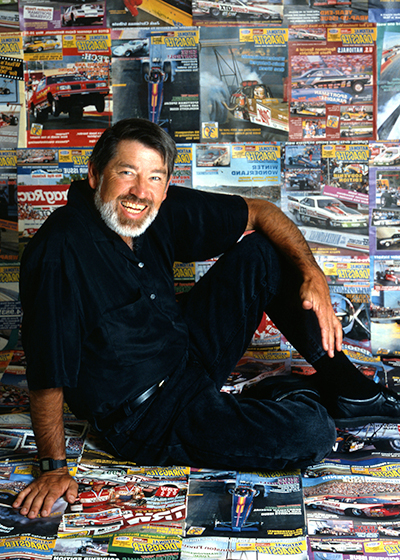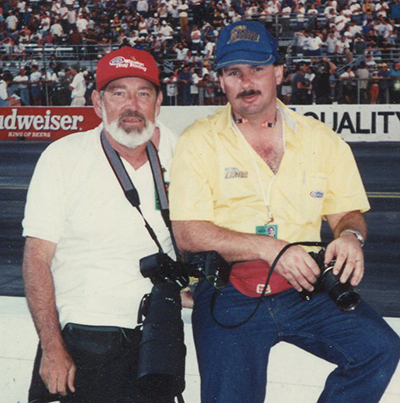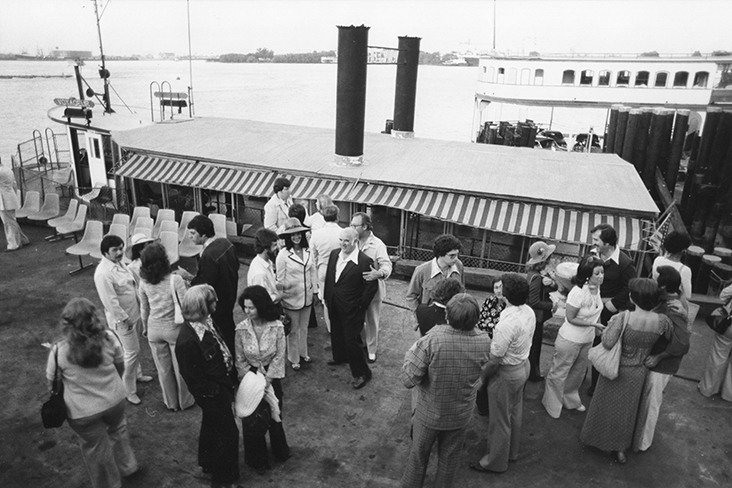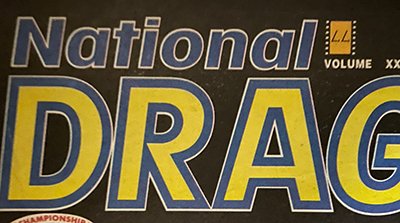

Remembering Leslie Lovett































































Even 25 years later, I still want to cry.
On July 2, 1996 — a quarter-century ago today — the NHRA world lost one of its finest people and greatest emissaries when National Dragster Photo Editor Leslie Lovett died of a heart attack while on an offshore fishing trip.
For nearly three decades, Lovett had been the lens through which much of the world viewed the NHRA, his images capturing the spectrum of our sport from pit-area thrashes to ontrack action and even the sport’s social side. He didn’t care if you were a multitime world champion or a perennial “first-round runner-up,” he loved you. He literally was every racer’s best friend.
What he meant to them and to the NHRA is incalculable; what he meant to his friends and colleagues on the National Dragster staff is indescribable, though I tried my best in a column that I pecked away at through tears that week. I’m going to reprint that here — it’s the indented stuff in case you want to read it straight through — but offering some thoughts about him that come to mind now.
For the last week, Southern California has basked in glorious beach weather: a hot sun beating down out of cloudless skies. Today, July 3, it is cloudy, and raindrops, like tears, dot the windshields of our cars. Today, as yesterday, we mourn the loss of our dear friend and colleague, Leslie Lovett.
I wasn’t trying especially to be poetic when I wrote those words, but it was true about the weird weather. It just seemed like God was crying with us. For years afterward, as we all experienced more losses and sadness, many times the sky would be gloomy and leaky, and Teresa Long, Leslie’s soulmate and protégé, would often sidle up to me and softly say, “Phil, it’s raining,” and I knew she wasn’t just talking about the weather.
On a warm and summery day in 1982, I walked through the glass doors of NHRA headquarters in North Hollywood to interview for the position of assistant editor at National Dragster. I was led into a conference room, where I met the small Dragster staff. Two of them I recognized instantly: Wally Parks and Leslie Lovett. Anyone who had followed drag racing for any length of time knew them and of their importance to the sport.
No one ever forgets meeting Wally Parks: I won't forget meeting Leslie Lovett.
While meeting Wally was like meeting the deity of your chosen religion, as a young fan whose knowledge of the sport came from the photographers of the 1970s, Leslie and his photo pals also were like gods to me, and there were a lot of them: Steve Reyes, Jim Kelly, Bob McClurg, Jon Asher, Jere Alhadeff, Barry Wiggins, Richard Brady, Tim Marshall, Rick Shute, Dave Kommel, Norman Blake, Jeff TInsley, John Shanks, Alan Earman, Paul Sadler, Les Welch, et al. It was the golden age of drag racing photographers. Through Leslie, I was able to meet them all.
Chris Martin probed my knowledge of the sport, George Phillips my journalistic background, and Wally my desire; Leslie just wanted to be friends. When I walked back through the doors two weeks later and joined the NHRA family, Leslie was one of the first to make me feel welcome.
NHRA is still a family to me, and within that family, the National Dragster staff is an even closer family, 40 or more proud and diligent professionals working closely under incredible stress-inducing deadlines to produce the best possible product each week, and Leslie was a big part of this family.
I grew up in a relatively small family, with just one sister. My family emigrated to the United States from England when I was a child, so all of my relatives lived thousands of miles and an Atlantic Ocean away, but the ND staff became my brothers and sisters, and Leslie was everyone’s big brother. My first road trip with the staff was with Leslie to the 1983 SPORTSnationals in Indy, where he introduced me to his world, taught me how to travel, and how to represent the magazine.
Anyone who worked around Leslie knew that he was like a fuel engine on 100-percent nitro. As today's crew chiefs will tell you, it's all a matter of timing. If your timing was off, Leslie could blow up in your face. Or, he could be the most helpful person on the staff.
I fancied myself quite the photojournalist way back then, full of confidence in my skills. It took only my first photo assignment, a match race at Orange County Int'l Raceway, to prove at least half of that wrong. I found, as many aspiring and established photographers have found, that beneath Leslie's sometimes gruff exterior was a heart of gold.
I always knew I could write, but wanted to be the complete package, but I wasn’t. Getting to be on Leslie’s “team” would be like a basketball star who suddenly finds out he gets to play with LeBron James.
Leslie taught me almost everything I know photography, critiquing my proof sheets, offering advice and inspiration. As I learned, he progressively trusted me with better and better equipment. Whenever I lucked upon a quality image, he was as excited and proud for me as was for myself. We worked a lot of races together, and whenever he and I teamed up for a feature, l always introduced us the same way: "I’m words he's photos." Yes, a lot of us can take pictures; Leslie took photographs.
You can see just a small chunk of that work in the gallery at the top of this page, a collection handpicked long ago by Teresa, who, like me, learned a lot about photography from the master. She obviously learned a lot more than me, as she went on to become his brilliantly-capable successor as Photo Editor, continually raising the bar as he had done, until her retirement from the magazine a few years ago.
When I first became editor of this magnificent publication in 1986, Leslie and I bumped heads often. But if you worked with him long enough, you grew to understand how much he loved this publication, this sport, and this company, and if he argued with you, it was just him trying to get across what he thought was an important point.
I know he felt the same way about this paper that I do, and I felt that if you ever cut Leslie, he would bleed blue and yellow. I was never more honored than when during an NHRA Today feature on Leslie, he took time to cite me as a reason for the paper's success.
L.L., it was you, buddy. You shot the pictures that the whole drag racing world clamored to see. The words, they just took up the white space around your images.
We used to joke about Leslie because he once called himself "the eye of the National Hot Rod Association." But now when I think of him, it's not that funny; it's true.

I was the brash young kid, just 26 when I took over the editorship of National Dragster, and L.L. had been there since the late 1960s. The things I wanted to do to "his" magazine were sometimes foreign to him. Once we got on the same page, we were Batman and Robin.
Leslie died just about a year after we launched NHRA.com in 1995, and not a lot of people had access to digital cameras back then. And that was only six or seven years after National Dragster switched from mostly black and white photos to a full-color publication. The ability to showcase his photos in color, to show people how the sport really looked, delighted him. And with the web, space was no longer an issue. I'd love to know how he would have fared and innovated in a digital world.
Like that nitro engine, Leslie was a powerhouse at the track. He Was everywhere, and it's hard to remember when Leslie didn't have a shot I came looking for. Whether it happened on the track, in the pits, or at some swank affair across town, Leslie had it or made sure someone else had it. He always had a camera at the ready — whether it was a full-blown Hasselblad rig, a versatile Nikon, or a pocket-sized point-and-shoot model, Leslie was there to chronicle it all: races, NHRA Christmas parties, special gatherings, even my wedding. He was an editor's dream, and doubt whether anyone can ever replace him.

Back in the 1970s and early 1980s, when the entire NHRA staff was smaller, when there were fewer races, and when no one had a laptop to go back to the hotel to work on or a cellphone that required constant checking, it wasn't uncommon for the entire working staff at a race to go out together to dinner or even a concert or some other fun activity. There were a lot of organized events before races, too, dinners with state officials, crawfish boils and riverboat rides and golf tournaments, and even dog-racing outings.

At some of the larger events, Sportsman tech would be held in the parking lot of a local mall, and Leslie would be there, shooting and mingling. Leslie's work didn't begin when the first car fired up or end after the last one shut down. If you invited him, he'd come to your shop. The photo above was from the 1983 Springnationals, Paul Mayo invited us to his nearby shop. Leslie was probably tired, hungry, or both, but went because Paul asked. Leslie was a dynamo.
I can't begin to eulogize in this space a man I have known, loved, and respected for 14 years, a man who many others more qualified have known for decades. In a future issue, we will put together a remembrance of our friend, and | encourage everyone who had a good thought about Leslie to contribute.

We did do that; and in fact, beginning in the issue after his passing, we incorporated a logo on the cover — the initial L.L. in a camera-film box — that stayed on there all year, just as we did a year ago after we lost another great and loyal member of our team, Matt Hurd. The last issue that Leslie worked on was the July 12, 1996 issue that was underway when he passed, and it's the one that carried my column and the news of his passing. One of the cover subjects was Blaine Johnson, whom we would tragically lose just a few months later in a terrible qualifying crash at the U.S. Nationals, a day before nitro motorcycle great Elmer Trett also was also killed at Indy. 1996 was a very sad year.
As we as a staff blink through Our tears again, today as yesterday, we can force a small smile because we know that Leslie died pursuing his other passion, fishing. And if I know Leslie, he's already got a Nikon strapped around God's neck, giving him casting lessons.
We'll miss him every day — his talent, his inspiration, the camaraderie, and we'll never forget him. Godspeed, my friend.

It's been 25 years. In some ways, it seems much longer than that, and in others, it feels so fresh. When I pull photos for this column or for or 70th-anniversary features for the magazine, his fingerprints are all over them still. His legacy will always be a part of our magazine, carried on now in the capable hands of Jerry Foss, who was still kind of new on the staff when Leslie died, and his collection of at-event help that includes the amazing Mr. Shute and his Auto Imagery team still clicking after all these years. Leslie would be proud. There also aren't a lot of racers competing today who had the good fortune to meet and know Leslie — OG guys like John Force, Ron Capps, Antron Brown, Cruz Pedregon, Doug Kalitta, Steve Johnson, and Gary Densham are the only ones who spring to mind in the pro ranks — but I'm sure they share my love and admiration for him.
He was one of a kind. And I still do miss him every day.
Phil Burgess can be reached at pburgess@nhra.com
Hundreds of more articles like this can be found in the DRAGSTER INSIDER COLUMN ARCHIVE



















































